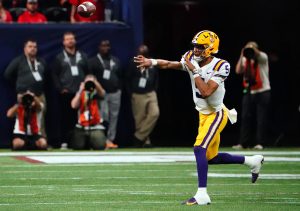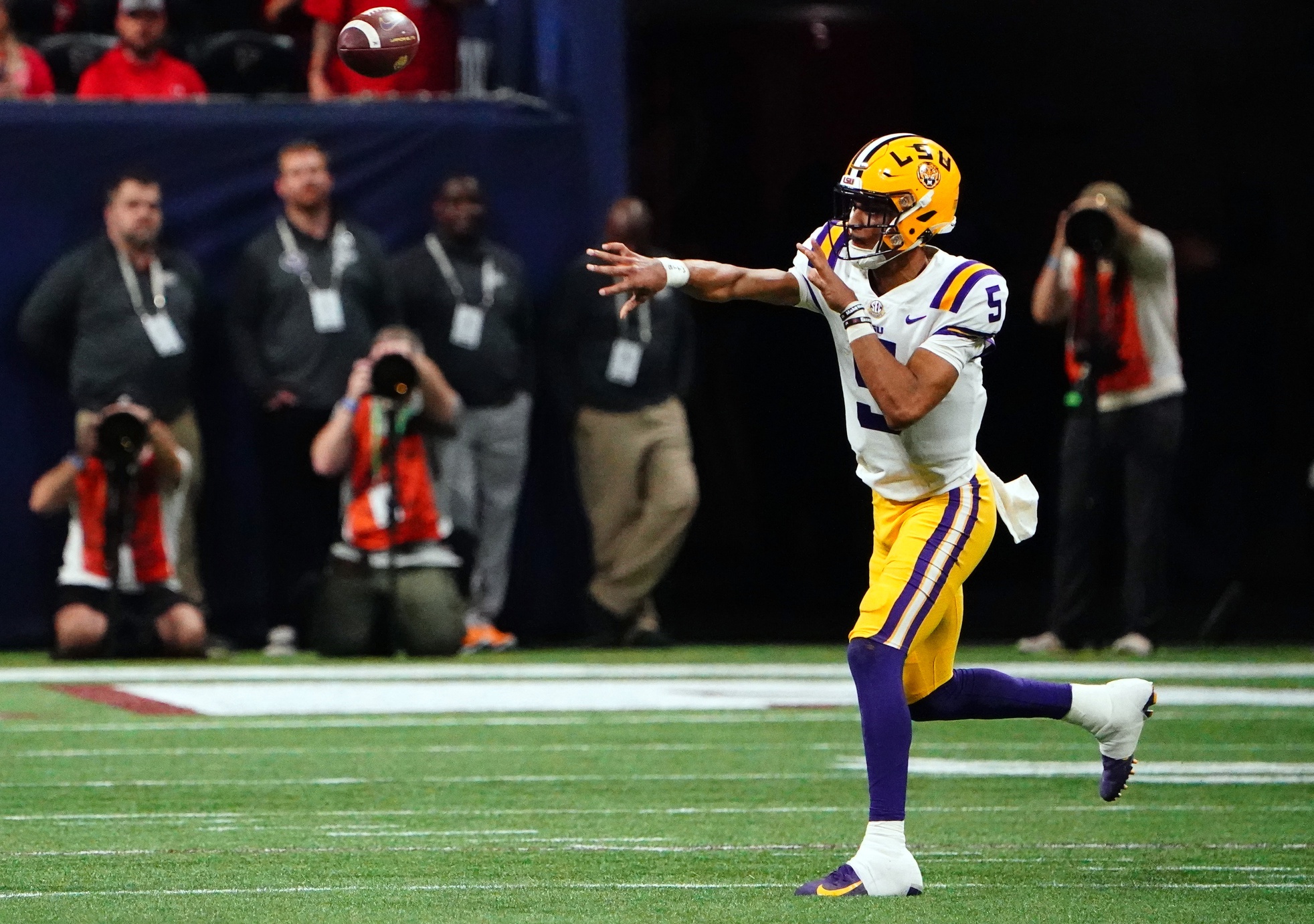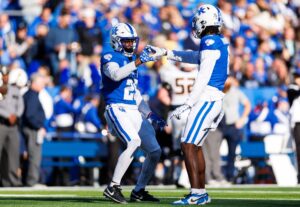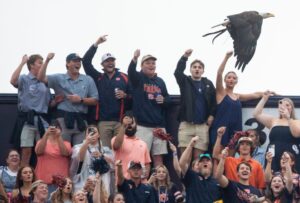LSU Quarterback Jayden Daniels and the Bengal Tigers have a few notable commonalities. Tigers have ample amounts of speed and quickness, and so does Daniels. Tigers have stripes; Daniels plays on a field with stripes. Tigers don’t wear shoes; Daniels lost his shoe because that’s all safety Donovan Kaufman could tackle when LSU played against Auburn.
The talented signal-caller showed flashes of brilliance in his first year with the Tigers, but there is still much room for improvement in his passing game. One of Daniels’ most significant areas of focus this offseason is improving his ability – and confidence – to throw the deep ball.
The Need to Take More Chances
One of the most significant criticisms of Daniels’ passing game last season was his reluctance to push the ball down the field. There were a few too many instances where he glossed over deeper routes in progressions. A bigger head-scratcher came in the instances Daniels got tunnel vision on his check-downs, seemingly running through no progressions at all.
Daniels averages 8.7 yards per attempt, and in SEC play that drops to just 6.9 yards per attempt. Remember those, because we’re going to address them more in-depth later. The point to be made right now, though, is that against stronger opponents he seems more hesitant to let the ball fly. These numbers are something that LSU offensive coordinator Mike Denbrock has been focusing on with Daniels throughout the offseason.
Denbrock’s Thoughts
As Denbrock noted in a recent interview, “It’s a mindset you have to drill like you drill any other mindset.” Simply put, Daniels needs to be willing to take more chances and trust his arm to make big plays happen.
Part of the problem, according to Denbrock, is that he may not have scripted enough long-passing plays in both practice and games. “It’s a lot easier to call another hitch route knowing that it’s going to be complete than it is to take a shot down the field,” he said. “But as a coach, we’ve got to be willing to do that.” Things can only improve by putting Daniels in practice situations where he has to make quick decisions and throw the ball deep. Through this approach, the coaching staff hopes to build Daniels’ confidence and get him comfortable taking those chances in games.
Denbrock also noted his hope to improve the frequency of catch and run passes, thus improving LSU’s yards-after-catch. He plans to do this by, “running a little bit more scheme-wise”, he said. “Where we can get the ball in our skill guys’ hands with their ability to turn up field, instead of having their back to the goal line.”
Promising Moments and Personnel
Despite his reluctance to throw long passes, there were moments last season where Daniels showed he has the ability to do so. In the Tigers’ 2022 contest against Florida, he made impressive long-yardage throws showcasing his arm strength and accuracy.
Your Honor, we offer 45-35 into evidence:
JAYDEN DANIELS THREW A PERFECT PASS TO PUT LSU ON TOP 😮💨 pic.twitter.com/5yVNP9zboj
— ESPN (@espn) October 16, 2022
As evidence, one could argue that if he can execute such plays in those games there’s no reason why he can’t do it consistently.
A factor that could help Daniels improve in this area is the personnel around him. Specifically, wide receiver Malik Neighbors and tight end Mason Taylor. The two will be key players in LSU’s passing game this season. Taylor is a crisp route runner with good vision after the catch, while Nabers has the speed to get behind defenses and make big plays. With these weapons at his disposal, and Brian Thomas Jr.’s vertical route running ability, Daniels should have plenty of opportunities to throw the ball down the field and make big plays.
Balancing Mobility and Passing
One of the reasons why Daniels is hesitant to throw the ball down the field is because he’s so good at running with it. He’s arguably the best running quarterback in college football and has a knack for making plays with his legs. However, this can also be a hindrance to his passing game. Daniels only threw 3 interceptions during the entire 2022 season. These low turnover numbers are due in part to his reluctance to throw – instead choosing to tuck the ball scamper for yardage. For more opportunities to arise, the Tiger quarterback needs to find a better balance between his mobility and passing.
One encouraging sign is that Daniels has shown he can be an accurate passer. His completion percentage of 68.6% last season is a testament to his ability to make quick, accurate throws. Such a figure is astounding considering that Daniels does have moments where he looks uncomfortable in the pocket. Percentages north of 67% are usually a sign of a pocket-passer by nature. According to the numbers, the foundation and skills are there. The challenge now is to build on that accuracy and become more comfortable throwing the ball down the field. If he can do that, he’ll be a much more well-rounded quarterback and a dangerous weapon for the LSU offense.
Breaking Down the Numbers
Take a stroll through cfbstats.com and you’ll find ample amounts of statistics you didn’t know were tracked at all. When you’re trying to seek elusive keys for improvement (as in this case), it’s mighty helpful. Did you remember those stats we mentioned earlier? Well, if you didn’t, just scroll up. We’re about to nerd out.
The Bronze Standard
For a reference point, let’s compare the passing statistics previously mentioned to those of another mobile quarterback. Namely, last year’s Heisman Trophy winner Caleb Williams, who averaged 10.2 yards per attempt. He also threw 46 completions of 25 or more yards. Some may say it’s unfair to compare the two. The fact is, they’re both athletic, veteran quarterbacks, who led their respective teams to the conference championship game just last December. That doesn’t mean that Daniels needs to be the next Heisman Trophy winner. It merely shows a lot of room for attainable improvement. Though, it would be all but wrong for us not to hold him to a Heisman standard. In fact, Vegas Insider has him tied at number seven in 2023’s Heisman Trophy odds.
Additional Statistics To Ponder
Let’s throw out a few more numbers just for chuckle-snorts. Last season Daniels threw 17 passes for 25 yards or more (29 fewer than Williams). Most odd, 12 of those came when the game was within seven points in either direction. One would think a quarterback would be more inclined to take higher-risk throws in lower-risk situations. Such as when his team has a large lead and it matters less, or when his team is down by multiple possessions and he needs to play catch up. Daniels’ throwing tendencies seem to function in the opposite manner. Adding to that, 82% of those completions of 25 yards or more came in the first half. What do we do with this information? Likely just tell our coworkers by the water cooler and forget about it tomorrow, but it’ll make a heck of a speculative conversation.
In the end, statistics only tell part of the story. Usually the boring part, unless you enjoy movies like Moneyball (guilty). In that case, obscure stats are your love language. Surprise, we’re dating now.







